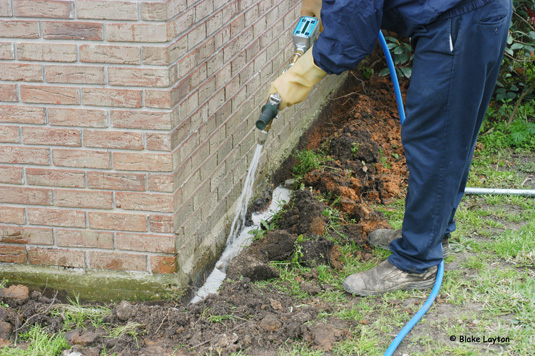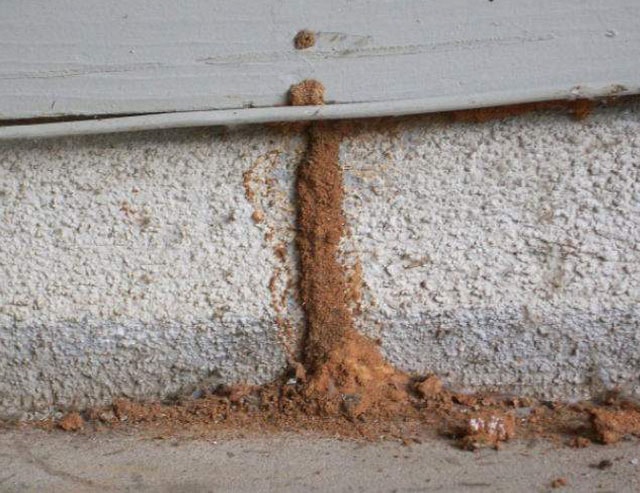What Is Termite Treatment?

So What Is termite Treatment?
Difference Between Termite Treatment & Anti-Termite Treatment
Types of Termite Treatment
Pre-construction Anti-Termite Treatment
Pre-construction anti-termite treatment involves applying termite control measures before building a structure. This proactive approach helps prevent termite infestations right from the start.
Importance at Various Stages:
Foundation Stage: Treating the soil before laying the foundation creates a barrier that repels termites. This prevents them from entering the structure through the ground.
During Construction: Incorporating termite-resistant materials and applying chemical barriers during construction ensures long-term protection against termite attacks.
Prevents Future Infestations: By addressing termite control early in the construction process, homeowners can avoid costly repairs and minimize the risk of termite damage in the future.
Post-construction Anti-Termite Treatment
Post-construction anti-termite treatment involves applying termite control measures to existing structures. This method is essential for addressing termite infestations in buildings that were not pre-treated.
Importance:
Detects Existing Infestations: Post-construction treatment helps identify and eliminate termite colonies that may have already infiltrated the structure.
Protects Property Value: By eradicating termites and preventing further damage, post-construction treatment preserves the value and integrity of the property.
Ensures Long-Term Protection: Regular post-construction termite inspections and treatments help maintain a termite-free environment, providing peace of mind for homeowners.
Understanding Termite Species
Subterranean Termites
Subterranean termites are one of the most common types found in the United States. These termites typically build their colonies underground and require soil contact to thrive. They create mud tubes to navigate through soil and access wood structures in homes. Subterranean termites are known for their destructive capabilities, causing significant damage if left unchecked.

- Characteristics:
- Require soil contact for survival.
- Build mud tubes for traveling and protection.
- Colonies can contain hundreds of thousands of individuals.
- Behavior:
- Feed on cellulose-based materials found in wood and other plant matter.
- Infest structures from the ground up, starting with foundation wood.
Formosan Termites
Formosan termites are notorious for their aggressive behavior and large colonies. Originating from East Asia, these termites have spread to various parts of the world, including the United States. Formosan termites can cause rapid and extensive damage to wooden structures due to their voracious appetite. They are known to infest not only homes but also trees and other wooden materials.

- Characteristics:
- Known for their aggressive behavior.
- Have large colonies with millions of members.
- Spread rapidly and can cause extensive damage in a short time.
- Behavior:
- Build carton nests in addition to underground colonies.
- Infest not only homes but also trees and wooden structures.
Drywood Termites
Drywood termites differ from subterranean and Formosan termites in that they do not require soil contact to survive. Instead, they infest dry wood directly, making them a common threat to wooden furniture, framing, and other wooden components of homes. Unlike subterranean termites, drywood termites do not build mud tubes, making their presence harder to detect. Infestations can go unnoticed until significant damage has occurred.

- Characteristics:
- Do not require soil contact, infest dry wood directly.
- Colonies are smaller compared to subterranean and Formosan termites.
- Can survive in relatively low moisture environments.
- Behavior:
- Infest wooden structures without leaving visible signs such as mud tubes.
- Damage wooden furniture, framing, and other wooden materials.
Termite Treatment Options
Liquid Termiticide Treatment
When it comes to combating termites, one effective method is the liquid termiticide treatment. Here's how it works:
Trenching Around the Foundation: Professionals dig a trench around the foundation of the building.
Application of Termiticide: A special chemical called termiticide is applied into the trench. This creates a barrier that prevents termites from entering the building.
Effectiveness: This method is particularly effective against subterranean termites, which are a common type of termite.

Termite Bait Stations
Another method for termite control is the use of bait stations. Here's how they function:
Placement of Bait Stations: These stations are strategically placed around the property, typically in areas where termite activity is observed.
Slow-Acting Poison: Inside the bait stations is a slow-acting poison. Termites are attracted to this poison and carry it back to their colony.
Elimination of Colony: As termites share the poison with their colony mates, it spreads, ultimately leading to the elimination of the entire colony.
Eco-Friendly: Bait stations are considered eco-friendly because they target only termites and pose minimal risk to other organisms.

Fumigation
Fumigation is a more intensive method of termite treatment:
Tenting the House: The entire building is covered with a tent-like structure to contain the fumigant gas.
Use of Fumigant Gas: Specialized gas is then pumped into the sealed structure. This gas permeates all areas, reaching and killing termites wherever they may be.
Effectiveness: Fumigation is effective against all species of termites but requires careful planning and safety precautions due to the toxicity of the gas.

Termite Bond/Warranty
Many pest control companies offer a termite bond or warranty for ongoing protection:
Coverage: With a termite bond, homeowners are provided with ongoing protection against termite infestations.
Retreatment Procedures: If termites are discovered during the coverage period, the pest control company will typically retreat the property at no additional cost.

By understanding these various termite treatment options, homeowners can choose the method that best suits their needs and preferences while effectively protecting their property from these destructive pests.
Signs of a Termite Infestation
Visual Signs
Mud Tubes
- Termites construct mud tubes to travel from their nests to a food source, usually wood. These tubes are typically found along walls, foundations, or other structures. They serve as protective pathways for the termites, keeping them moist and safe from predators.

Swarmers (Winged Termites)
- Swarmers are winged adult termites that emerge from mature colonies to mate and establish new colonies. They are attracted to light and are often seen swarming around windows, doors, or light fixtures, especially during spring.

Discarded Wings
- After mating, swarmers shed their wings, leaving them behind as evidence of their presence. Finding discarded wings indoors or around your property is a strong indication of a termite infestation.

Frass (Termite Droppings)
- Termite droppings, known as frass, resemble tiny wood pellets or sawdust. They are often found near infested wood or in areas where termites are active. Accumulations of frass can indicate the presence of a nearby termite colony.

Damaged Wood
- Termites feed on wood from the inside out, leaving behind hollowed-out structures and visible tunnels. Wood that sounds hollow when tapped or appears damaged, with maze-like patterns on its surface, may indicate termite activity.

Importance of Early Detection
Early detection of a termite infestation is crucial for several reasons:
Minimize Damage: Prompt identification allows for early intervention, minimizing the extent of structural damage caused by termites. Addressing the problem early can prevent costly repairs and structural compromises.
Lower Treatment Costs: Treating a termite infestation in its early stages is generally more straightforward and less expensive than dealing with a well-established colony. Early detection can save homeowners significant expenses on termite treatment and repairs.
Preserve Property Value: Timely detection and treatment help preserve the value of your property by maintaining its structural integrity and aesthetics. A termite-free property is more attractive to buyers and retains its market value.
Peace of Mind: Regular inspections and early detection provide homeowners with peace of mind, knowing that their property is protected against the destructive impact of termites. Vigilance and proactive measures can safeguard your investment and ensure a secure living environment.
By remaining vigilant for visual signs of termite activity and promptly addressing any suspicions of infestation, homeowners can protect their properties and minimize the potential damage caused by these silent invaders. Early detection is key to effective termite management and preserving the integrity of your home.
Prevention Tips to Avoid Future Termite Infestations
Termites can cause significant damage to your home if left unchecked. Here are some effective prevention tips to keep these destructive pests at bay.
Moisture Control
Moisture is like a welcome sign for termites, as they thrive in damp environments. Here's how you can control moisture to deter termites:
Fix Leaks: Inspect your home for any plumbing leaks and promptly repair them. Even small drips can create enough moisture to attract termites.
Proper Ventilation: Ensure good ventilation in areas prone to moisture buildup, such as the bathroom, kitchen, and basement. Use exhaust fans and dehumidifiers if necessary to keep humidity levels low.
Gutters and Downspouts: Clean out gutters regularly to prevent water from accumulating near your home's foundation. Ensure that downspouts direct water away from the house.
Eliminate Wood Contact
Termites feed on wood, so eliminating direct contact between wood and the soil can help prevent infestations. Here's how to do it:
Maintain a Gap: When building or renovating, ensure there's a gap between any wooden structures and the soil. This prevents termites from easily accessing the wood.
Use Termite-Resistant Materials: Consider using termite-resistant building materials for structures in contact with the ground, such as decks and porches. These materials are less appealing to termites and can provide an extra layer of protection.
Regular Inspections
Early detection is crucial in preventing termite infestations from causing extensive damage. Here's why regular inspections are essential:
Professional Inspection: Schedule annual termite inspections by a qualified pest control professional. They can identify signs of termite activity that may not be visible to the untrained eye.
Timely Intervention: If termites are detected during an inspection, prompt action can be taken to eradicate them before they cause significant damage. Early intervention can save you time, money, and stress in the long run.
By implementing these prevention tips, including moisture control, eliminating wood contact, and scheduling regular inspections, you can significantly reduce the risk of termite infestations and protect your home from costly damage.
Choosing the Right Termite Treatment
When it comes to dealing with a termite infestation, it's crucial to select the right treatment method. Here's a detailed guide to help you make an informed decision while considering professional pest control, inspection, and cost factors.
Importance of Professional Help
Why You Need Expert Assistance
When facing a termite problem, seeking professional help from licensed pest control specialists offers numerous advantages. Here's why:
- Expertise and Experience: Professional pest control technicians possess the knowledge and experience to accurately identify termite infestations and determine the most effective treatment methods.
- Safe and Effective Solutions: They use advanced techniques and products that are safe for your family and pets while effectively eliminating termites from your property.
- Comprehensive Inspection: Professionals conduct thorough inspections to identify the extent of the infestation and potential entry points, ensuring targeted treatment.
- Long-term Protection: Professional treatments often come with warranties or guarantees, providing assurance that your property remains termite-free in the long run.
Factors to Consider When Choosing a Treatment
Type of Termite Infestation
The type of termite infestation you're dealing with plays a significant role in determining the appropriate treatment method. Common types include subterranean, drywood, and dampwood termites, each requiring specific approaches for eradication.
Size and Structure of the Property
The size and structure of your property influence the choice of treatment. Larger properties or those with complex structures may require more extensive treatment measures to ensure complete termite eradication.
Environmental Factors and Safety Concerns
Consider the environmental impact and safety concerns associated with different treatment options. Opt for eco-friendly solutions that minimize harm to the environment and pose no risks to human health.
Cost Considerations
When evaluating treatment options, consider both the initial cost and long-term expenses. While some treatments may seem more affordable initially, they may require additional maintenance or re-treatment, making them costlier in the long term. Invest in treatments that offer effective protection against future infestations, thereby saving you money in the long run.
Getting Quotes and Comparisons
Importance of Obtaining Multiple Quotes
Before committing to a specific pest control company, it's essential to obtain quotes from several reputable providers. This allows you to compare prices, services offered, and treatment methods, ensuring you make an informed decision.
How to Compare Quotes
When comparing quotes, consider not only the cost but also the reputation of the company, the expertise of their technicians, and the effectiveness of their treatment options. Look for companies that offer transparent pricing, detailed treatment plans, and guarantees for their services.
By following these guidelines and considering professional pest control, inspection, and cost factors, you can choose the right termite treatment that effectively eliminates the infestation and protects your property for years to come.
Frequently Asked Questions (FAQ'S)
Q. What are the common signs of termite infestation?
Signs include hollow-sounding wood, discarded wings, mud tubes, and sagging floors. Regular inspections by professionals can help detect infestations early.
Q. How do I know if I need termite treatment?
Signs like mud tubes, damaged wood, and termite swarms indicate infestation. Consult a pest control expert for inspection and treatment recommendations.
Q. What are the types of termite treatment?
Pre-treatment methods include soil treatment and physical barriers. Post-infestation, options include liquid termiticides, baits, and fumigation, tailored to the severity of the infestation and property type.
Q. How effective is termite treatment?
Effectiveness varies based on treatment method, severity of infestation, and property type. Regular inspections and preventive measures enhance treatment efficacy.
Q. Can I do termite treatment myself?
DIY treatments may offer temporary relief but are often less effective than professional solutions. Professional pest control experts have the expertise and tools for thorough termite eradication and prevention.
Q. How long does termite treatment take?
The duration depends on factors like the extent of infestation and chosen treatment method. Treatment may range from a few hours for spot treatments to several days for fumigation.
Q. Is termite treatment good?
Yes, termite treatment is essential for protecting your property from costly damage caused by termite infestations. Regular treatment and preventive measures can help maintain the integrity of wooden structures.
Q. Which wood is termite proof?
While no wood is entirely termite-proof, certain types such as cedar, redwood, and teak have natural properties that make them more resistant to termite infestations. Treated woods with chemical preservatives can also deter termites.
